
|
||
|
Portland art blog + news + exhibition reviews + galleries + contemporary northwest art
|
||
Demos: Wapato Correctional Facility by Ernest 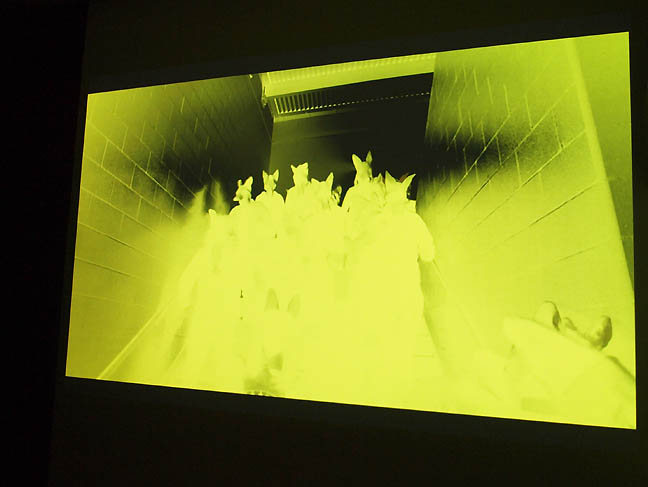 Scene From Demos: Wapato Correctional Facility by Ernest (all photos Jeff Jahn) PORT has been covering C3: Initiative's first residency program with Bay Area based Ernest for several years now and since there is just over a week left of their strong capstone exhibition Demos: Wapato Correctional Facility I felt it was a good time to report and evaluate. Though a lot of residency exhibitions turn into a sort of disparate show and tell exercise, Ernest's multi-year project has been both a longer engagement and ultimately more satisfying than nearly every other residency exhibition I've seen in Portland. Frankly, I like the trust and long term commitment both Ernest and C3 have shown. Partly this is because the scope was more ambitious and raised the stakes more than simply taking artists out of their element or giving them time and space to work. Don't get me wrong, there is nothing wrong with giving space and time. It is just worth noting that Ernest's time actually culminates in a strong exhibition, something residencies rightly are not always designed to produce. During their residency, Bay Area based collective Ernest engaged the St. Johns/Portland community through C3:Initiative. The residency/exhibition were facilitated during periods of intensive on site investigation and off site electronic conferences. During that time the artists zeroed in on the nearby and never used Wapato Correctional Facility. A prison in the Columbia Slough planned in the 1990's but based on now completely outdated assumptions of "helping" lower risk and mentally troubled inmates through "benevolent incarceration"... it never opened. If all that benevolence seems incredibly Victorian, it is. British social theorist Jeremy Bentham (1748-1831) conceived of a Panopticon prison design where the inmates would be under constant surveillance and it caught on during the Victorian period, eventually influencing the prison system in the USA. Americans have kept many of the patronizing parts of the philosophy alive, even after it was widely discredited in Europe during the 20th Century. I call it our Victorian traumatic stress syndrome (think about our attitudes towards sex, marriage, immigrants and morality). 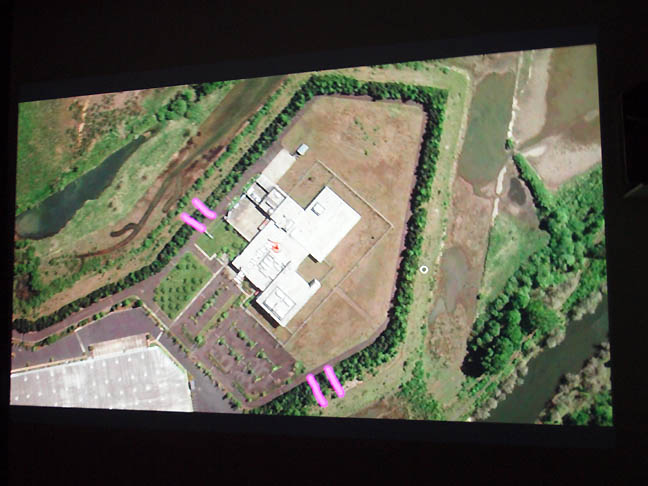 Google Earth's monitoring of Wapato In fact the USA has expanded this patronizing social attitude greatly and you see it in the way Homeland Security has been implemented by both Democrats and Republicans. In US prisons today digital surveillance and architecture is still designed to equate monitoring with power while making surroundings confusingly lacking differentiation of place and therefore any sense of "Home". It essentially infantilizes the inmate and brutally pathologizes (in quarantine) under the US prison system's 100% managed control... ensuring that re-integration with society will never happen. It is a monopoly... of lives. Because of an awakening of how wrong (and inefficient) this idea was in Portland in the early aughts Wapato never happened, except to taxpayers. In 2016 when the bonds are paid off Multnomah County can unburden itself and taxpayers of the facility... which is currently used for a shooting location for numerous shows and movies. Which is why Ernest produced their own video work titled Demos (Greek for "people"). I particularly liked walking around while viewing the disorienting video as it seemed to be like people's tour... although it is more of a maze than an orienting tour. 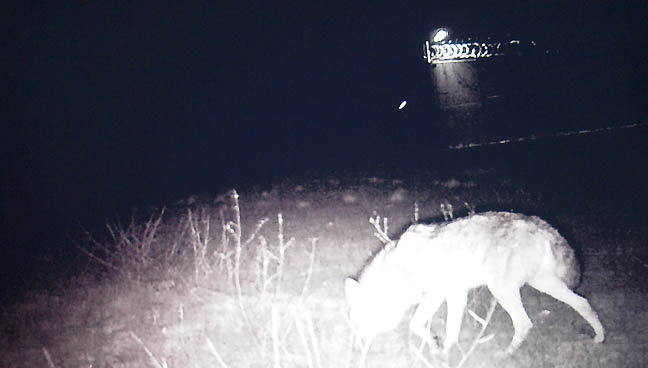
The stars of Ernest's production are the architecture, surveillance cameras and coyotes that have infiltrated the site. Perhaps summoning the beliefs of those who found this land sacred before Victorians came here... the coyotes are clever. The coyotes subvert security measures and show up throughout the video (more than a little like artists who overran Portland from the late 90's to the present). 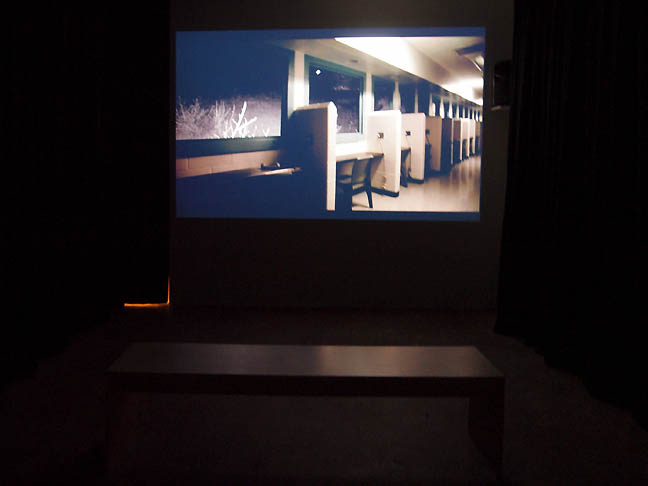 Calling Station sequence In one particularly brilliant sequence, a coyote appears in the windows that inmates would have viewed their visitors from as if to say, the unintended has a way of turning up for a visit... even without inmates. In other sequences a canine visitor roams the empty spaces, disrupting the human on human dialectic the building was built for. It is haunting and makes all of the uninhabited footage more pregnant with empty potential. Certainly the architects never considered coyotes, despite the fact they have always been there. A persistence of wildness usurps the architectural dialectic of human mastery and control. 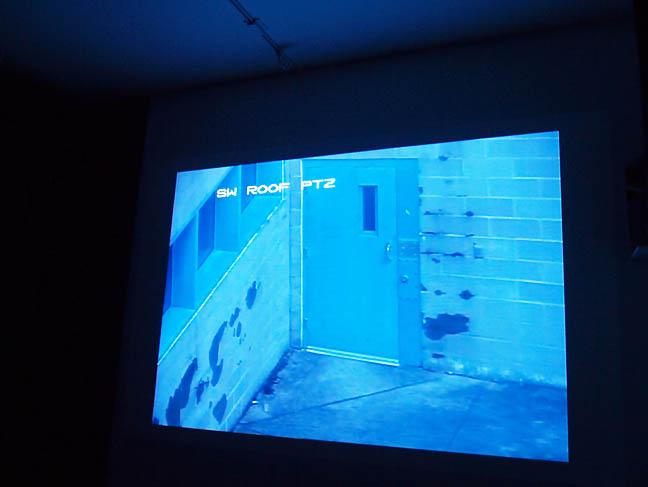
The coyotes are also interesting for the demonstration that humans often relate to animals better than our own kind and we never see humans in the video except for a scene with a bleeding tattoo of of a coyote. Nice touch and overall the video is well edited and paced. 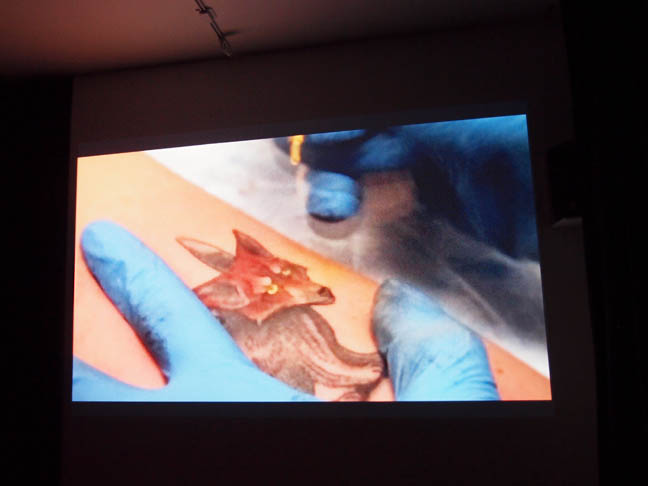
We hear the tattoo gun before we see it. Simultaneous video surveillance feeds documenting the lack of use, an inventory countdown of empty beds and tours of the guard's watching stations as well as a spinning Google Earth survey from the site show how Foucault's constant surveillance or Orwellian Big Brother descriptions don't even address the scope of today's pervasive monitoring. Attention is power but it is blind power without nuance and attentiveness. Ernest was very astute in documenting the lack, the sheer void of narrative in this place. It is a spatial palimpsest, no wonder film crews and artists love it (for very different reasons). At a time when "art space" is being reprogrammed into "creative space" in Portland the Wapato Jail in its completely interstitial program feels like a kind of zone for artistic freedom and less economic oversight. 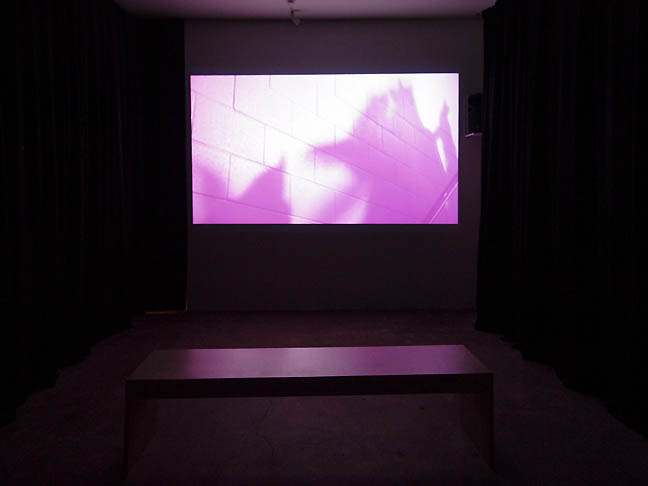
As part of their residency Ernest also created coyote costumes, which volunteers (many artists) donned to run through the jail's halls. It is a nice move how they tinted the video footage to make this softer approach less apparent. Showing the character masks more clearly would have diluted the video and broken the spell of anonymity of the place. Overall, most of the decisions worked well including the catalog printed by Container Corps, with two exceptions. On the back of the cover the words, "THIS PAGE INTENTIONALLY LEFT BLANK" is both too cute and pedantically pointless. The other consists of two sentences, "The following is a lie designed to obfuscate the overly simplistic intentions of the artist." "The preceding statement is a truth designed to clarify the subtly nuanced intentions of the artist." It is a lame, pointless art-school type posturing that would never survive any good crit session and doesn't belong with such serious subject matter. What is lovely about the book is the inclusion of newspaper articles, a filled out survey that Ernest distributed and some stitched in photos. If there is anything the exhibition really lacks it is a wall of this ephemera and larger versions of the still photography but I suppose the book itself is enough. Final thoughts? Jails are purgatories for prisoners and guards and the interesting thing here is the way Ernest explored the structure itself in a kind of limbo, despite having pre columbian settlement history and a kind of urban legend folklore on the streets of Portland. I applaud Ernest's restraint in exploring the nothingness at Wapato as a way to bring it back to the people or Demos. It is a document written in invisible ink so see the show before Wapato becomes something. Perhaps that is the success of this residency exhibition. Instead of showing how busy they were they showcased the odd and rare lack that exists at Wapato. Demos: Wapato Correctional Facility through November 22, 2015 @ C3:intitaive Posted by Jeff Jahn on November 14, 2015 at 13:36 | Comments (0) Comments Post a comment Thanks for signing in, . Now you can comment. (sign out)
(If you haven't left a comment here before, you may need to be approved by
the site owner before your comment will appear. Until then, it won't appear
on the entry. Thanks for waiting.)
|
| s p o n s o r s |
 |
 |
 |
 |
 |
 |
 |
 |
 |
 |
 |
 |
 |
 |
 |
 |

|
Site Design: Jennifer Armbrust | • | Site Development: Philippe Blanc & Katherine Bovee | |

